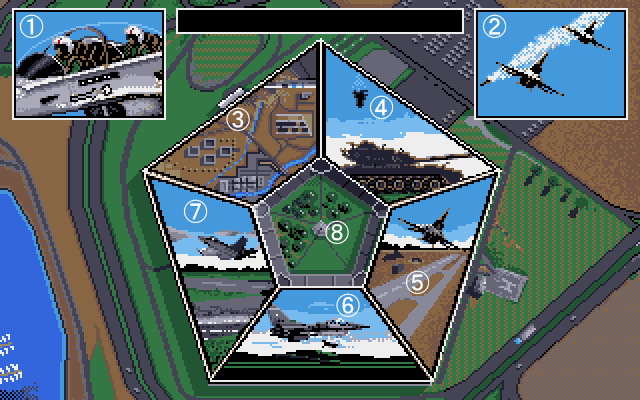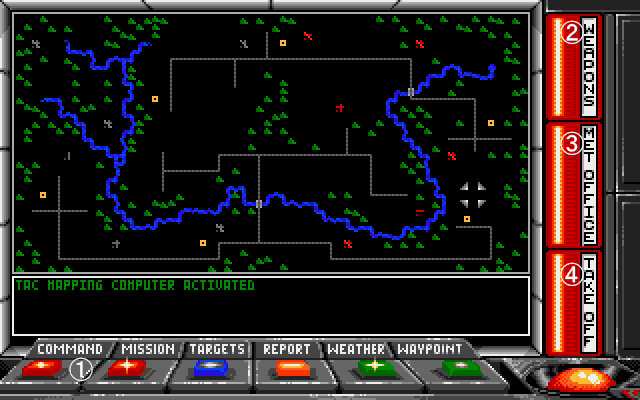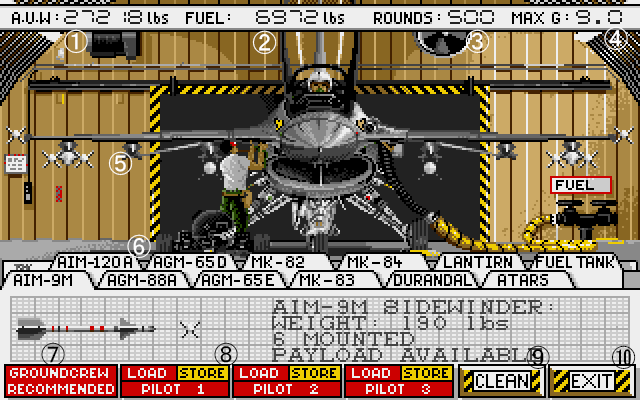
Controls
| Control | Action |
|---|---|

|
Pitch down |

|
Pitch up |

|
Roll left |

|
Roll right |

|
Centre controls |

|
Select target |

|
Fire |

|
Change weapon |

|
Secondary controls |

|
Airbrakes |

|
Virtual keyboard |
| Control | Action |
|---|---|

|
Increase throttle |

|
Decrease throttle |

|
Yaw left |

|
Yaw right |

|
Undercarriage |

|
Designate target |

|
Flares |

|
Chaff |

|
Secondary controls |

|
Wheelbrakes |

|
Autopilot |
| Mouse | Action |
|---|---|

|
Pitch down |

|
Pitch up |

|
Roll left |

|
Roll right |

|
Centre controls |

|
Fire |
F-16 Combat Pilot
This realistic combat flight simulator pits you and your Fighting Falcon against enemy pilots and their Foxhound, Flogger and Fulcrum jet fighters. Your cannon, missiles and tactical systems will help you to win dogfights. You’ll need all your piloting skills to survive. And when you return to base you’ll need to master the angle of attack to land your aircraft.
Crew room (main menu)

- Demonstration – plays a gameplay demonstration
- Weapon data – allows you to view information about some of the missiles that can be equipped
- Aircraft data – allows you to view information about the enemy aircraft that appear in the game
- Controls – originally allowed you to change between two flight control modes. On THEA500, this should always remain set to ‘Mode (A)’.
- Quickstart – immediately takes you into a training mission, with a general purpose loadout, and no pilot data loaded
- Pilot’s log – allows you to create new pilot data
- Missions – takes you to the Mission selection menu
- Recall game – originally allowed you to load previously saved pilot data. On THEA500, it is instead recommended to use the Save game feature.
Mission selection menu

- Training – a simple training mission
- Gladiator – originally this allowed you to play a one-on-one dogfight between two Amiga computers using a modem. THEA500 does not have this functionality.
- Watchtower – a reconnaissance mission.
- Tankbuster – a battlefield close air support mission.
- Hammerblow – an offensive counter air operations mission.
- Deepstrike – a ground attack mission.
- Scramble – an air-to-air interception mission.
- Operation Conquest – a full strategic campain. Only available once you have flown in each of the other missions (except for Training and Gladiator).
Pre-flight briefing menu

- Mode selector switches
- Command – (Operation Conquest only) aircraft assignment. Set targets for additional support F-16 aircraft.
- Mission – shows mission objectives
- Targets – toggle types of target to be displayed on the map
- Report – shows additional intelligence reports relevant to the mission
- Weather – shows a weather forecast
- Waypoint – allows you to set up to 5 custom waypoints
- Weapons – takes you to the Weapon loading menu
- Met Office – (not available in Operation Conquest) select weather condition options
- Take Off – begin the mission
Weapon loading menu

- All-up-weight
- Fuel weight
- Gun rounds loaded
- Maximum g rating for current loadout
- Hardpoints
- Weapon selection – select a weapon then click a hardpoint to load. Some weapons can only be loaded on the inner hardpoints.
- Load recommended loadout
- Load/save custom loadouts
- Clear all currently loaded weapons
- Return to the pre-flight briefing
Available weapons/other equippable items
- AIM-9M Sidewinder
- Infra-red short range air-to-air missile. Maximum range: 11 miles.
- AIM-120A AMRAAM
- R-guided medium range air-to-air missile. Maximum range: 30 miles.
- AGM-88A HARM
- Radar-guided anti-radiation missile for use against EWR sites.
- AGM-65D I/R Maverick
- Infra-red air-to-ground missile for use against tanks. This weapon is normally used with the LANTIRN system which acquires targets automatically, however it is possible to lock a Maverick onto a target without LANTIRN providing the target is in visual range (approximately 3 miles). Having selected the Maverick, the first press of the fire button will “pickle” the target (i.e. lock on), then the second press will launch the missile. This only works with “hot” targets such as tanks. Range: about 9 miles.
- AGM-65E laser Maverick
- Laser-guided air-to-ground missile for use against all ground targets except runways. This weapon requires LANTIRN. Range: about 9 miles.
- MK-82 Snakeye ret. bomb
- Free fall bomb
- MK-83
- 1000lb free fall bomb
- MK-84
- 2000lb free fall bomb
- Durandal
- Anti-runway bomb
- LANTIRN
- Night vision and laser guidance system. Always fitted for night missions. Attaches either side of the engine intake (under the nose).
- ATARS reconnaissance pod
- Reconnaissance pod. Can only be loaded on the centre line hardpoint.
- External fuel tank
- Provides 4400 lb of extra fuel (per pair of tanks).
The aircraft is always fitted with the following:
- M61A1 internal cannon
- 500 rounds. Range: approximately 2000 feet.
- Chaff and flares
- 30 of each. For use as decoys against incoming missiles. Each active for approximately 30 seconds.
Game interface

- G-force
- Heading
- Mach number
- Airspeed
- Target designator
- Pitch bars
- Lock-on diamond
- Altitude
- Ranging reticle
- Master caution light
- Threat warning panel
- Radar warning receiver
- Up front control panel
- CNI datalink
- UHF communications
- Attitude direction indicator
- Airbrakes light
- Wheelbrakes light
- Engine failure light
- Fire warning light
- Data entry panel
- External tanks empty light
- Fuel low warning light
- Engine rpm indicator
- Reheat indicator
- Undercarriage lights
- Jettison light
- Left MFD
- Angle of attack indicator
- Centre MFD
- Vertical speed indicator
- Right MFD
- Fuel gauge
- Engine rpm indicator
MFD displays
 Flight data
Flight data-
- IAS
- indicated airspeed (not true airspeed) in knots
- ALT
- altitude in feet
- VSI
- vertical speed indicator (rate of climb/descent) in feet per second
- HDG
- aircraft heading in degrees
- FUEL
- weight of fuel in lbs
 Air radar
Air radar- Shows range in miles (top left corner), altitude in thousands of
feet (top right corner), and bearing in degrees (bottom right
corner) of enemy aircraft. Modes switch when a target is designated,
or dogfight mode is engaged. Range: approximately 30 miles.
- TWS
- Track-While-Scan mode. Can track up to 4 enemy aircraft simultaniously.
- STT
- Single-Target-Track mode.
- ACS
- Air-Combat-Scan (dogfight) mode. Automatically selects the nearest target within 10 miles.
 Ground radar
Ground radar- Shows range and bearing of ground targets. Mode switches when a
target is designated. Range: approximately 10 miles.
- GTR
- Ground-Target-Ranging mode. Equivalent of air radar’s TWS mode.
- GTT
- Ground-Target-Track mode. Equivalent of air radar’s STT mode.
 Moving map
Moving map- Shows your position within the combat zone
 Weapons status
Weapons status- Shows the status of your loaded weapons
 Digital artificial horizon
Digital artificial horizon- A digital equivalent of the mechanical instrument
 ILS
ILS-
Instrument Landing System. This display helps you line up with the runway centre line and approach the airfield along the correct glidepath.
In order to use the ILS, you must fly into the radio beam cone transmitted from either end of each runway by approaching the runway lined up approximately North-South (i.e. on a heading of either 180 or 360) or East-West (i.e. a heading of 90 or 270) and with an altitude of less than 5000 feet. The cone is widest at the maximum range of the ILS (approximately 10 miles).
The yellow needles show the aircraft’s alignment to the runway centreline (the vertical needle) and the correct glidepath (the horizontal needle). When lined up, the yellow needles will cross in the centre of the display.
 Zoom thermal image
Zoom thermal image- Will appear blank until a target is identified. Shows an image of the target.
Up front control panel

The letter in the top left of the up front control panel shows the current mode (Waypoint, Airfield, and Target) and the number the current channel.
- RNG
- Range in miles
- BRG
- Bearing in degrees
- ETA
- Estimated time of arrival at waypoint or airfield
- ALT
- Altitude of target
To the left of the text display are 6 lights arranged in two rows of three lights each. These indicate:
| Light column 1 | Light column 2 | Light column 3 |
|---|---|---|
| Recce pod activated | LANTIRN system active | Radar active |
| ILS in range | Autoland active | Transmit callsign active |
Threat warning panel
- SA
- Incoming surface-to-air missile
- AA
- Incoming air-to-air missile
- EC
- Electronic countermeasures detected
- IF
- Incoming enemy fighter
- EW
- Enemy radar lock detected
Flight
Take off
To taxi to the runway, increase the throttle to between 65% and 75%. Do not allow your speed to exceed 50 knots as you taxi.
Once on the runway and lined up with the centre line, increase the throttle to 100%. To activate reheat (maximum thrust) release and re-press the throttle-up button.
As your speed approaches 150 knots, pitch up to take off.
Remember to raise the wheels shortly after take off.
Landing
You can only land on an airstrip.
With the throttle at 80% and the wheels down your speed should be between 120 and 140 knots. Use the airbrake if necessary.
Adjust your altitude to under 2500 feet and approach the airstrip. Keeping the nose of the aircraft approximately 5° above the horizon will ensure a good approach speed and a rate of descent of roughly 11 feet per second. The ILS will help you to line up with the centre line and correct glidepath.
Just prior to touchdown, pitch up very slightly to reduce the rate of descent to less than 10 feet per second.
After touchdown, reduce the throttle to 60% (the minimum) and apply the wheelbrakes until the aircraft stops. Taxi into a hangar to complete the mission.
Autoland
To use the autoland feature, ensure the ILS is active and in range, then press the autopilot button.
Ground Control Approach
With the desired airfield selected on the up front control panel, press the transmit callsign button, then the request GCA button, then follow the instructions from the control tower.